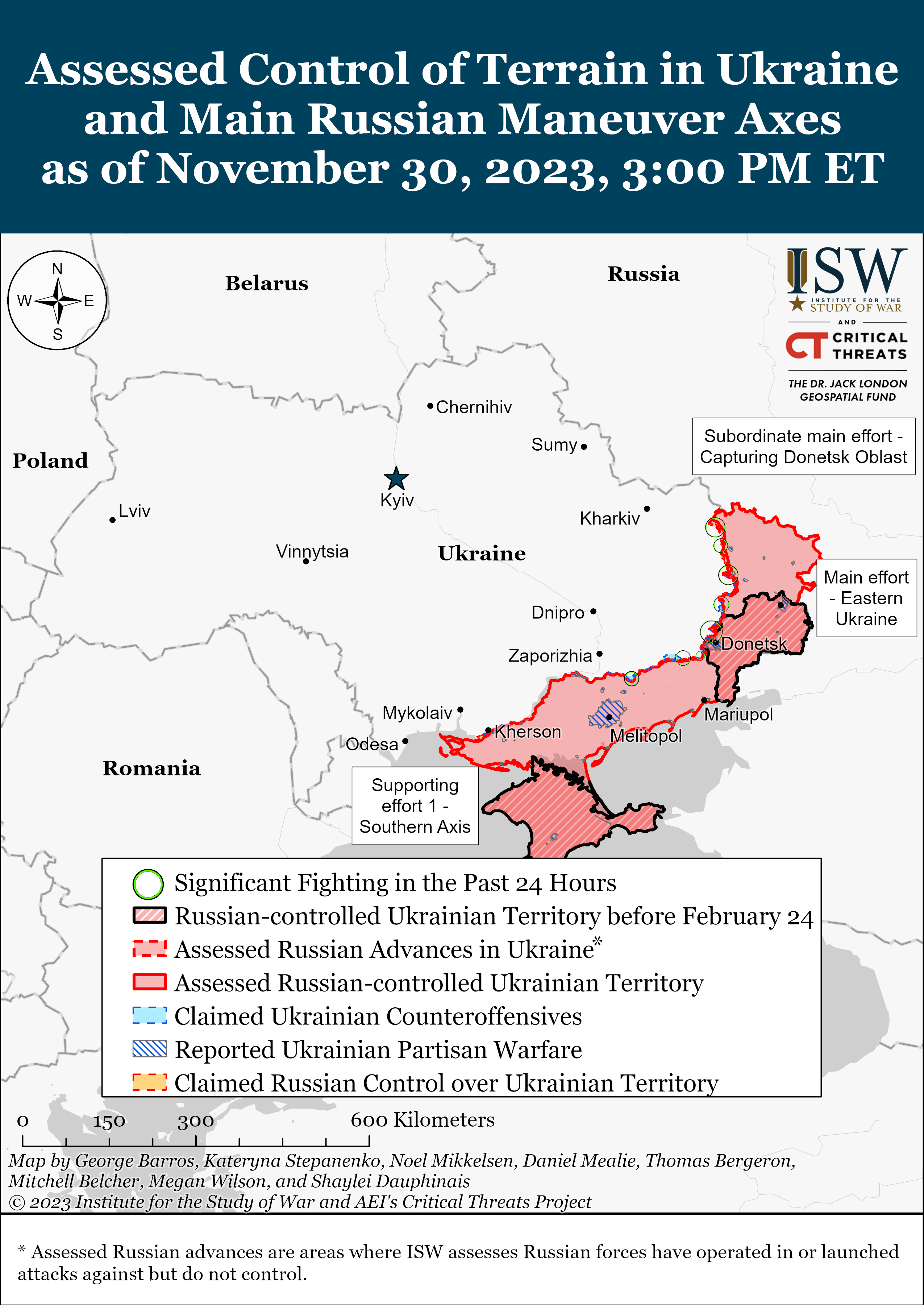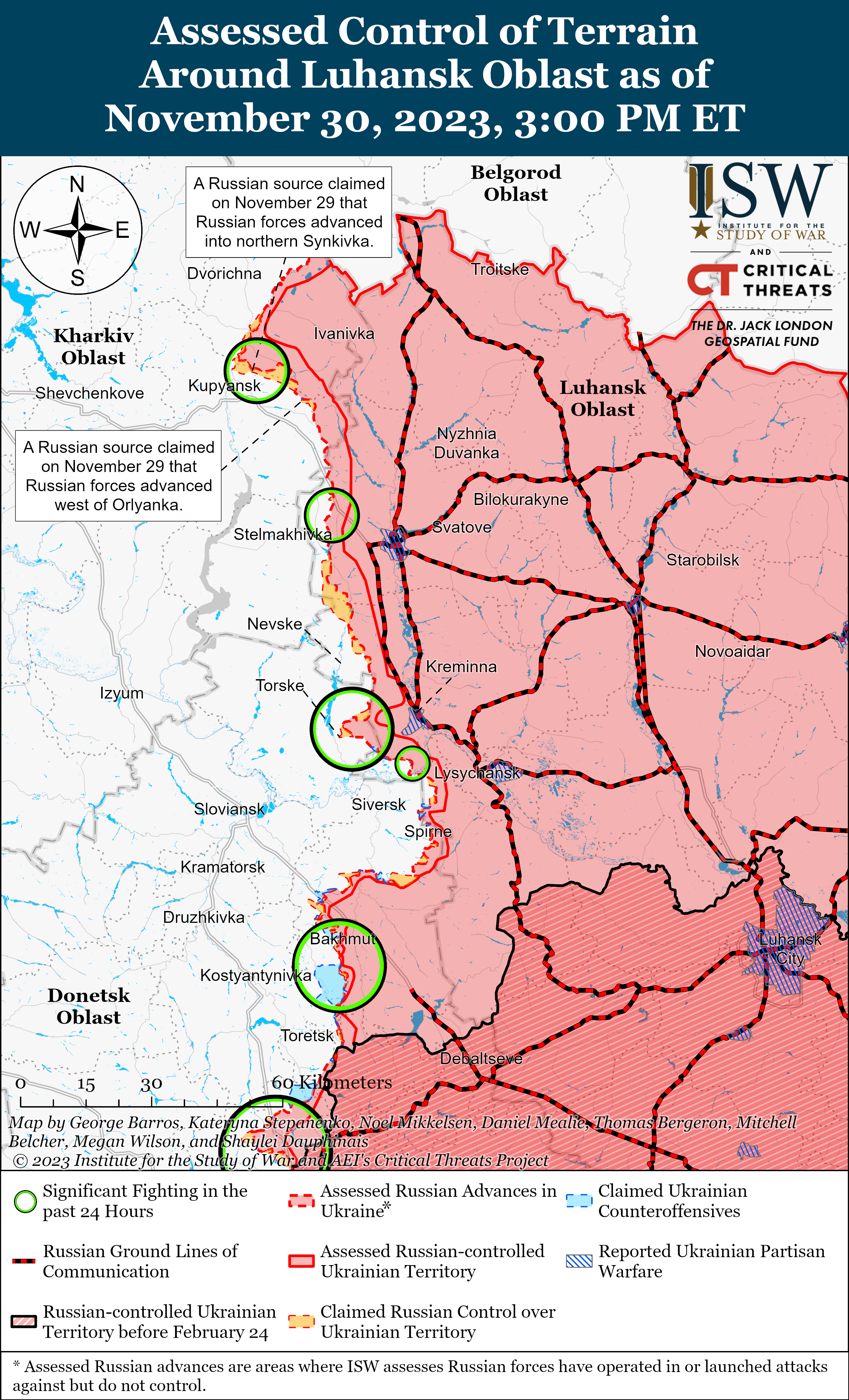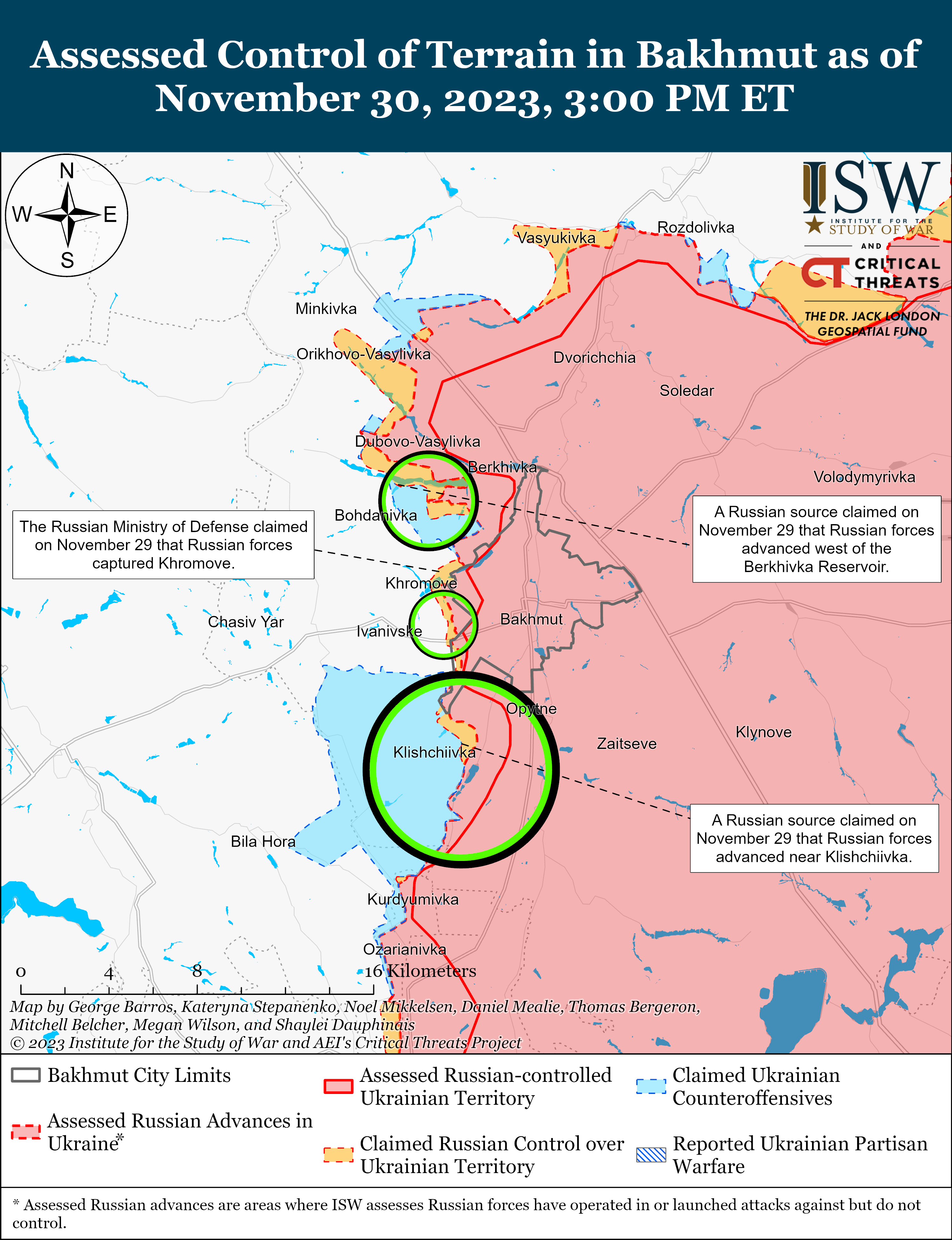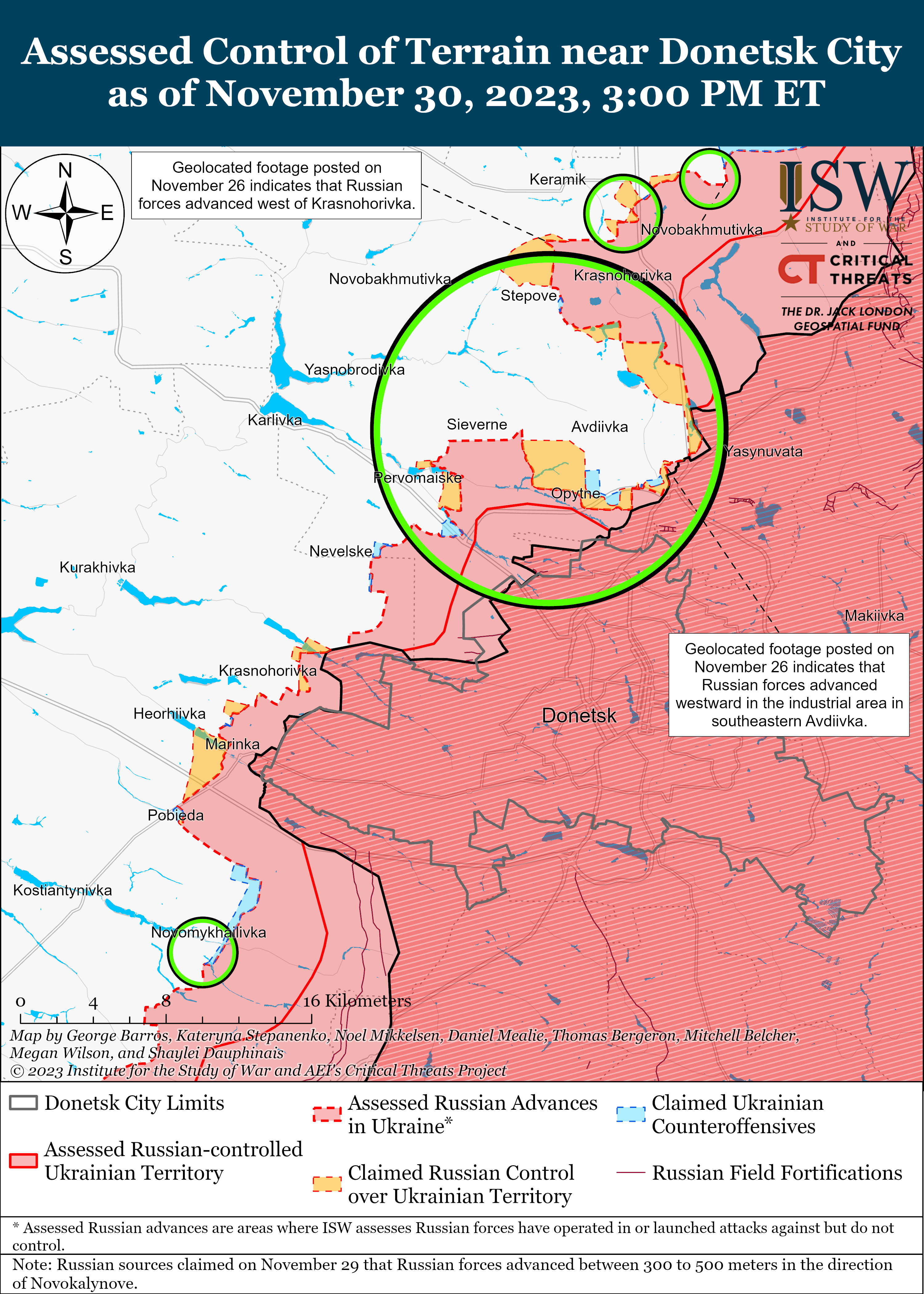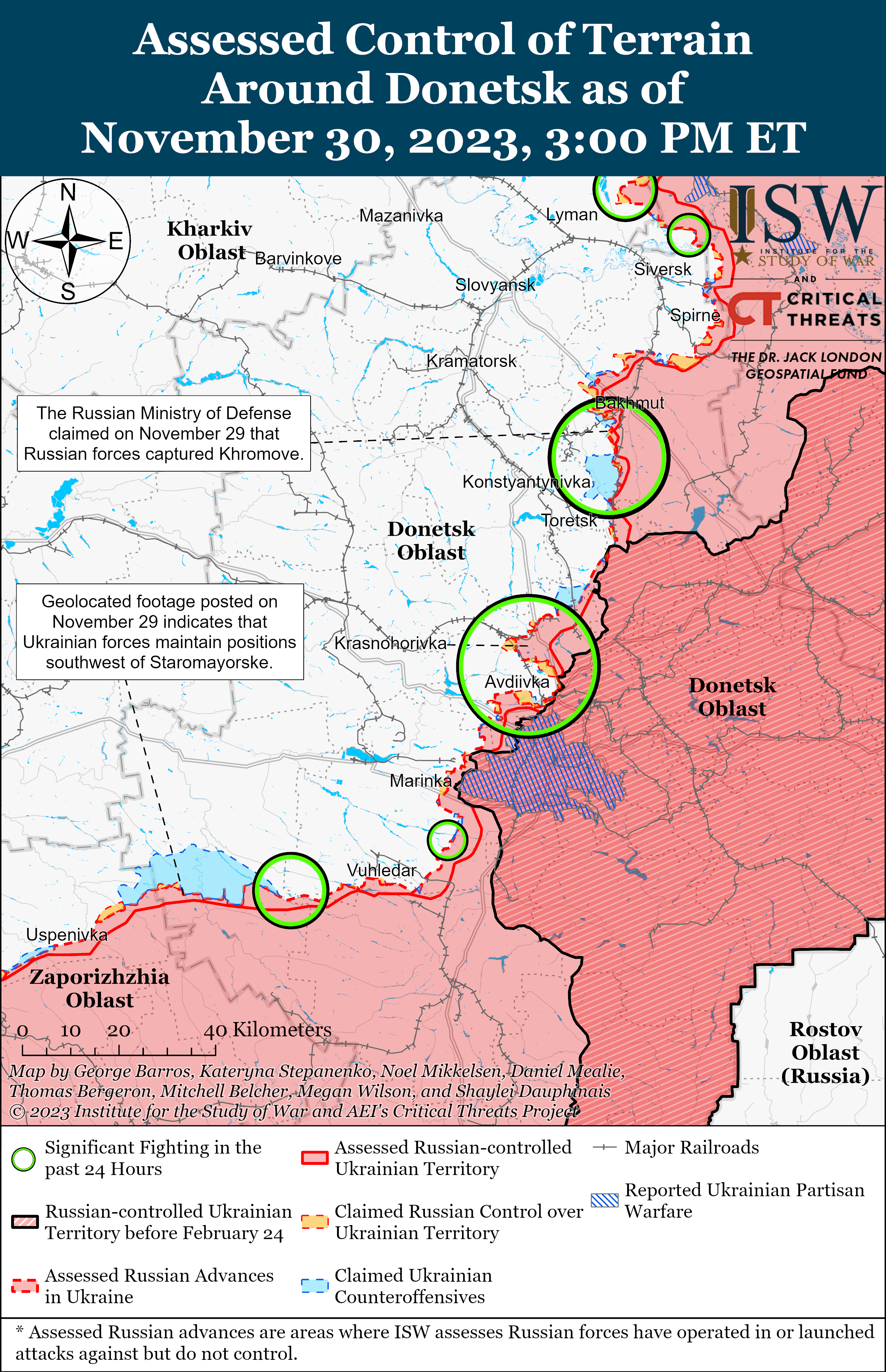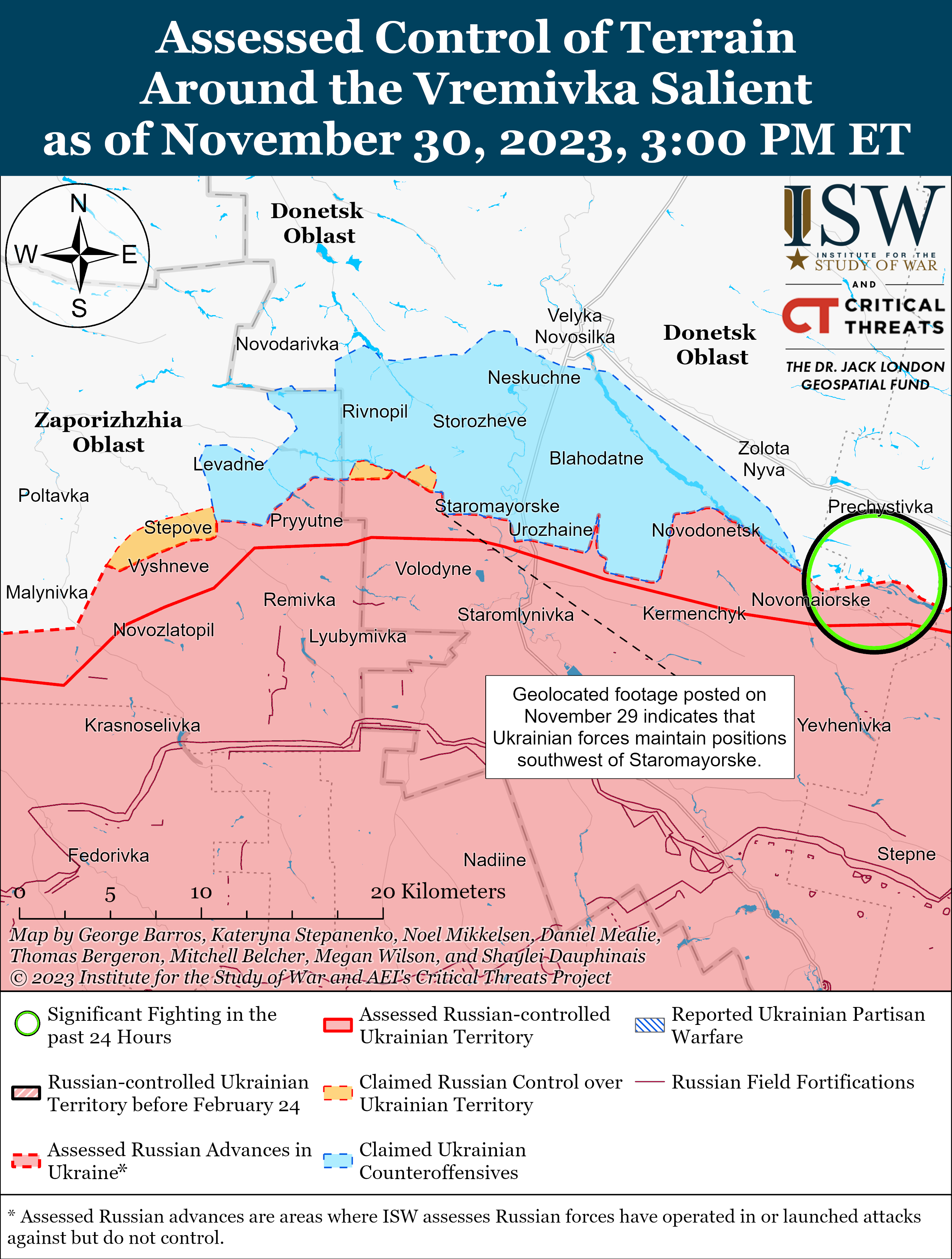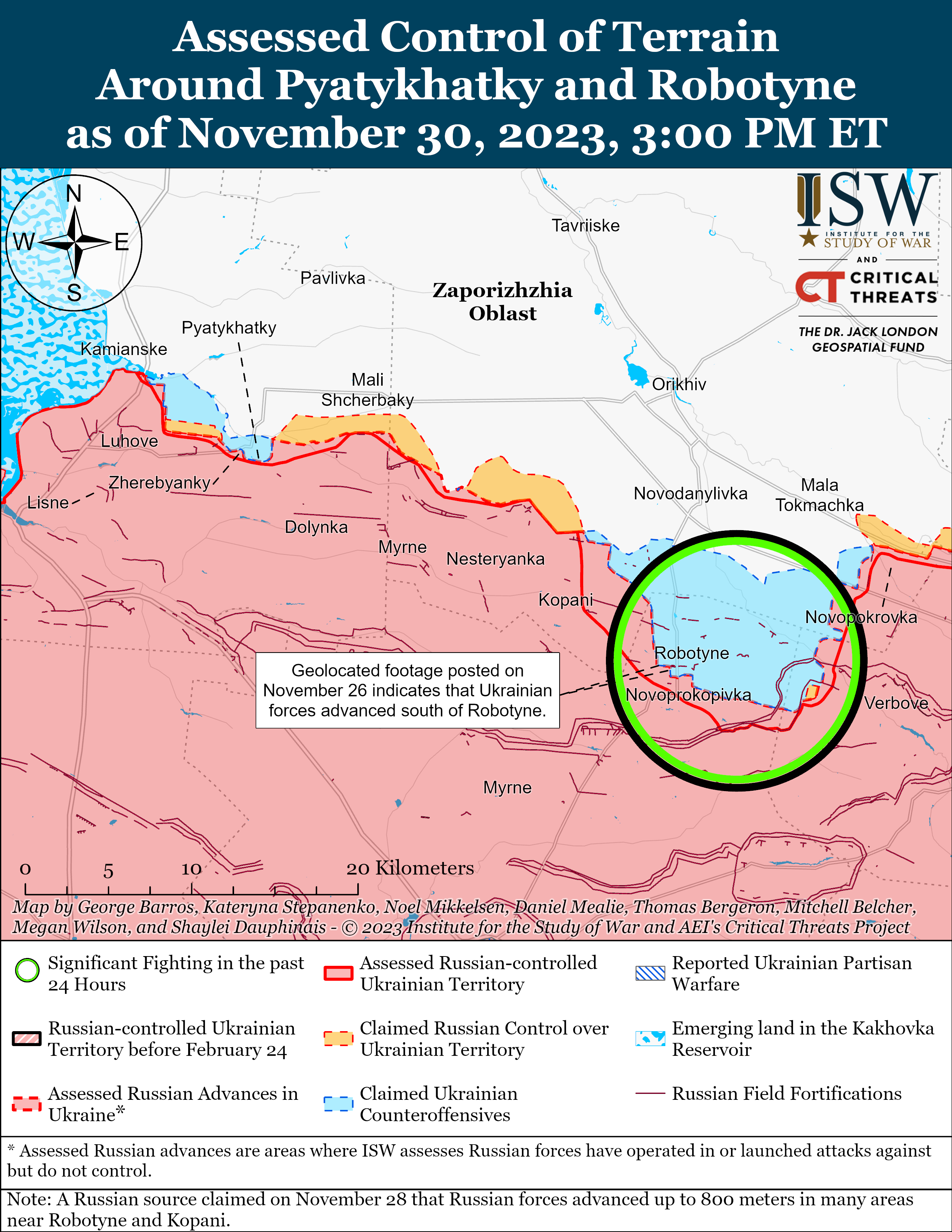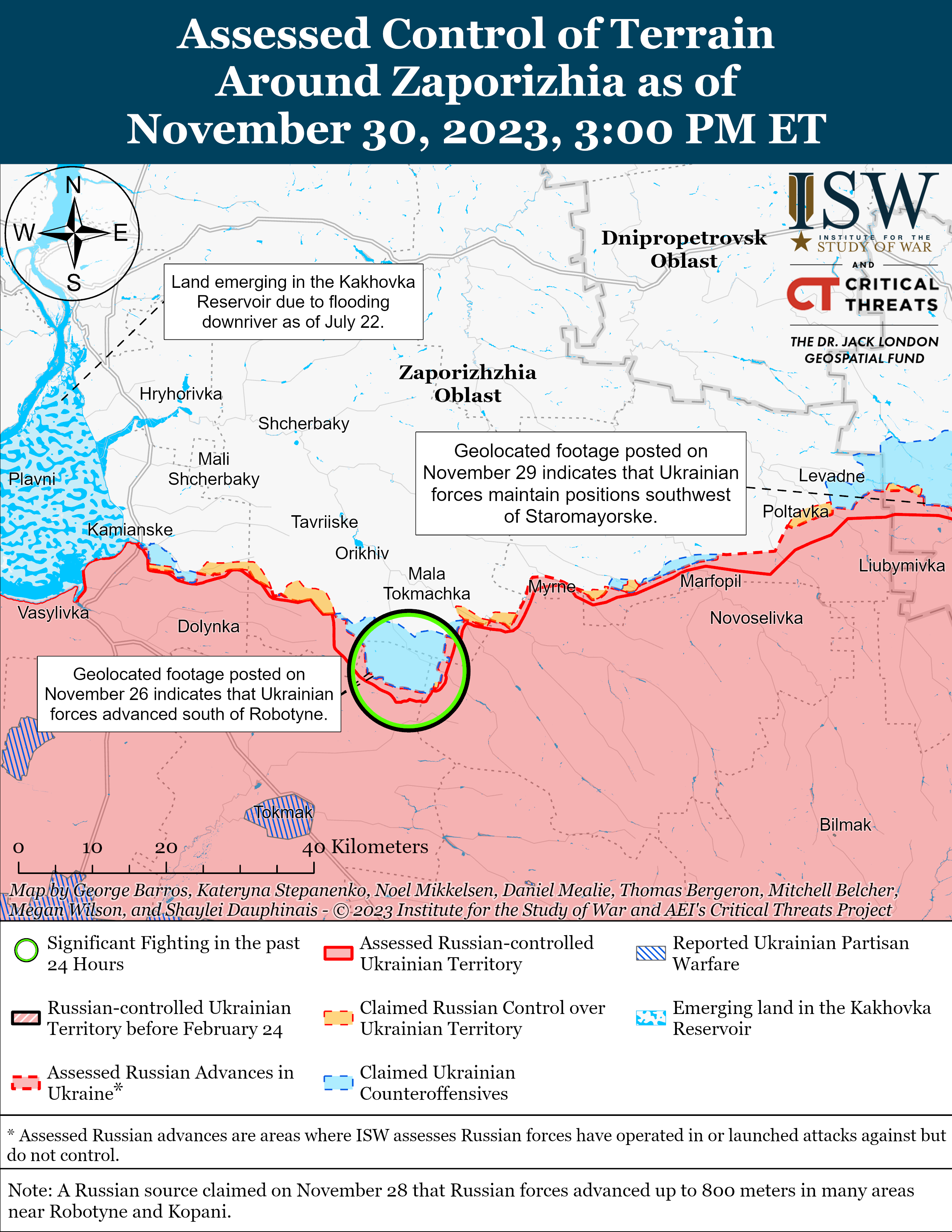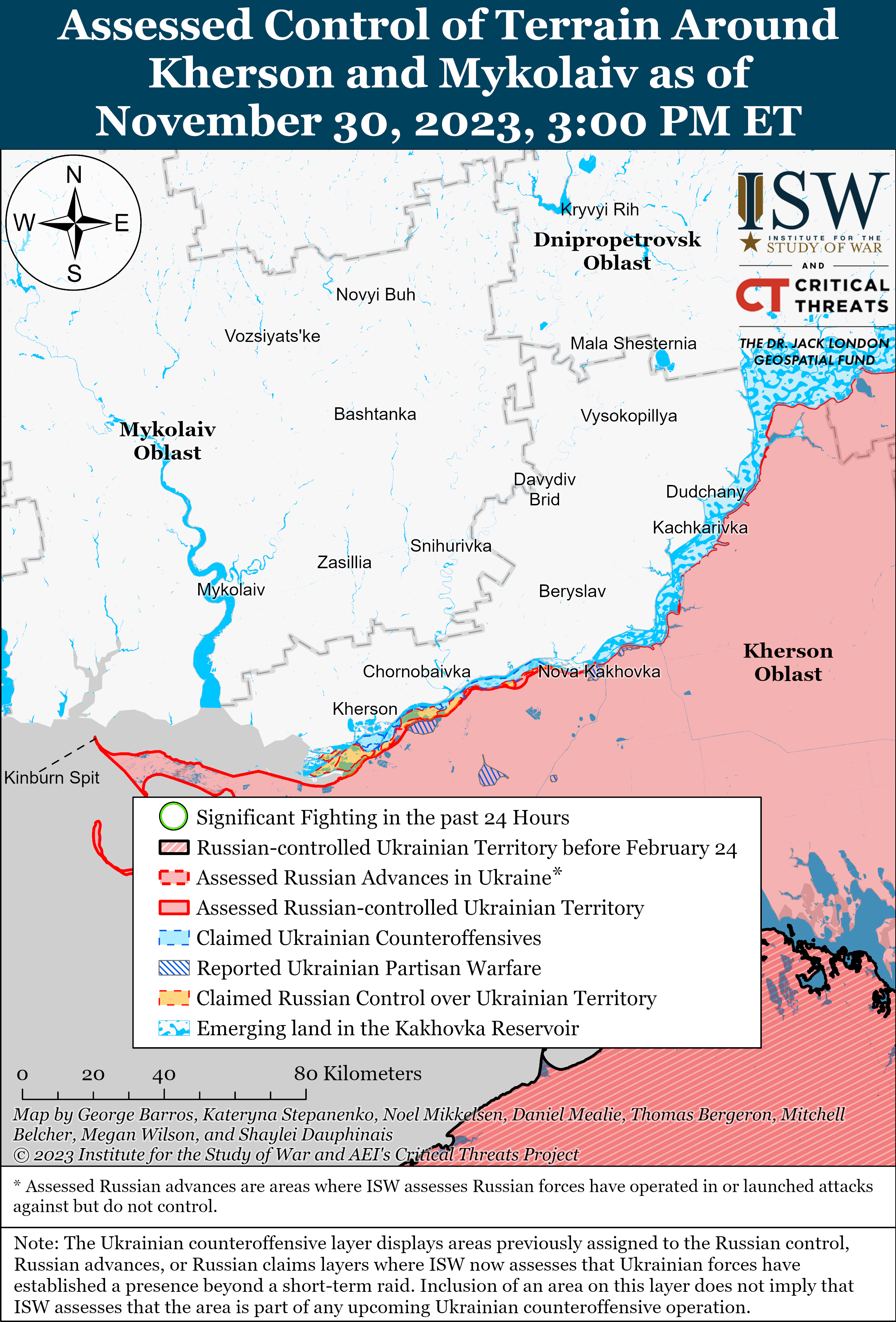Russian Offensive Campaign Assessment, November 30, 2023
Nicole Wolkov, Christina Harward, Angelica Evans, Grace Mappes, Riley Bailey, George Barros, and Frederick W Kagan
November 30, 2023, 6:45pm ET
Click here to see ISW’s interactive map of the Russian invasion of Ukraine. This map is updated daily alongside the static maps present in this report.
Click here to see ISW’s 3D control of terrain topographic map of Ukraine. Use of a computer (not a mobile device) is strongly recommended for using this data-heavy tool.
Click here to access ISW’s archive of interactive time-lapse maps of the Russian invasion of Ukraine. These maps complement the static control-of-terrain map that ISW produces daily by showing a dynamic frontline. ISW will update this time-lapse map archive monthly.
Note: The data cut-off for this product was 12:40pm ET on November 30. ISW will cover subsequent reports in the December 1 Russian Offensive Campaign Assessment.
A recent Russian opinion poll indicates that the number of Russians who fully support the war in Ukraine has almost halved since February 2023 and that more Russians support a withdrawal of Russian forces from Ukraine than do not. Independent Russian opposition polling organization Chronicles stated that data from its October 17-22, 2023, telephone survey indicates that respondents who are “consistent” supporters of the war – those who expressed support for the war, do not support a withdrawal of Russian troops from Ukraine without Russia having achieved its war aims, and think that Russia should prioritize military spending – decreased from 22 percent to 12 percent between February 2023 and October 2023.[1] Chronicles stated that 40 percent of respondents supported a withdrawal of Russian troops from Ukraine without Russia having achieved its war aims, and that this number has remained consistent at about 39 to 40 percent throughout 2023. Chronicles stated that 33 percent of respondents did not support a Russian withdrawal and favored a continuation of the war and noted that this number has been consistently decreasing from 47 percent in February 2023 and 39 percent in July 2023. Recent polling by the independent Russian polling organization Levada Center published on October 31 indicated that 55 percent of respondents believed that Russia should begin peace negotiations whereas 38 percent favored continuing the war.[2]
The Russian war in Ukraine has created new social tensions and exacerbated existing ones within Russia, which remain highly visible in the Russian information space despite ongoing Kremlin censorship efforts. Relatives of mobilized personnel continue making widespread complaints and appeals for aid for mobilized personnel despite reported Russian efforts to censor such complaints.[3] Russian opposition outlet Vazhnye Istorii reported on November 29 that Russians have sent over 180,000 complaints about issues concerning the Ministry of Defense (MoD) to the Russian Presidential Office for Working with Citizens’ Appeals since the start of the full-scale invasion of Ukraine in 2022.[4] The majority of these complaints reportedly concern payments to soldiers, mobilization status, missing persons, and poor medical care.[5] The Kremlin has also been capitalizing on recent ethnic tensions in Russia to support ongoing force generation measures and appeal to Russian ultranationalists, establishing a cycle that keeps these tensions at the forefront of ultranationalist dialogue.[6] The Ukrainian Main Military Intelligence Directorate (GUR) reported that protest activity and social tension are increasing in Russia, particularly in western Russia, due to the war in Ukraine and that the top echelons of Russian leadership are discussing these tensions.[7] The GUR noted that increasing crime, alcohol abuse, inflation, and high consumer goods prices also contribute to rising social tensions, and many of these factors are likely exacerbated by the continued Russian war in Ukraine.[8] The Kremlin has consistently failed to place Russian society on a wartime footing to support the Russian war effort, and the shifting poll numbers and exacerbated social tensions indicate that this failure is having a tangible effect on Russian society ahead of the 2024 Russian presidential elections.[9]
The Kremlin is likely concerned about how changing Russian perceptions of the Russian war in Ukraine will affect the outcome of the March 2024 Russian presidential election and is implementing measures to ensure that Russian President Vladimir Putin’s actual electoral support does not rest on Russian battlefield successes. Russian President Vladimir Putin will reportedly center his presidential campaign on Russia’s alleged domestic stability and increased criticism of the West instead of focusing on the war.[10] Putin and other Russian government officials have already signaled their intention to intensify censorship efforts by claiming that some Russian citizens who left Russia and others still in Russia have begun efforts to discredit the upcoming Russian presidential elections and that Russia will do “everything necessary” to prevent election meddling.[11] Russian authorities have also attempted to consolidate control over the Russian information space and have intensified measures encouraging self-censorship.[12] Russian milbloggers suggested that Russian political officials financing Telegram channels ordered milbloggers to cease debates and criticisms about the Russian military prior to the Russian presidential elections.[13] The Kremlin has likely attempted to shore up popular support for Putin throughout Russia by establishing a network of “proxies” to campaign on Putin’s behalf.[14]
Kremlin Spokesperson Dmitri Peskov confirmed on November 30 that Russian President Vladimir Putin will hold his annual live “Direct Line” forum and annual press conference in tandem on December 14.[15] Putin will likely use the tandem event to roll out his still unannounced presidential campaign following the official start of the Russian presidential campaign season on December 13.[16]
Russian Foreign Minister Sergei Lavrov notably did not promote Kremlin information operations feigning interest in negotiations during his speech at the Organization for Security and Cooperation in Europe (OSCE) Council of Foreign Ministers meeting in North Macedonia on November 30, and instead promoted escalatory rhetoric about Moldova. Lavrov claimed that the OSCE is turning into an appendage of NATO and the European Union (EU) and said that the organization is “on the brink of an abyss.”[17] Lavrov’s speech notably did not include a long-standing Russian information operation aimed at portraying Russia as willing to negotiate with Ukraine.[18] Lavrov previously claimed on November 27 that the West is currently trying to “freeze” the war to gain time and rearm Ukraine for future attacks on Russia.[19] The OSCE is meant to serve as a neutral platform in negotiations, among other functions, and would have provided an appropriate diplomatic forum for Lavrov to promote negotiations with the West, but Lavrov notably made no such overture. Russia previously weaponized the OSCE’s Special Monitoring Mission in Ukraine to support Russian information operations to obfuscate Russia’s participation in its initial hybrid war against Ukraine, which Russia began in 2014, and to support Russian operations.[20] Russian forces reportedly commandeered OSCE off-road vehicles to support Russian combat operations in Luhansk Oblast in January 2023.[21] Lavrov’s criticism of the OSCE reflects Russia’s continuing unwillingness to engage in serious cooperation with the OSCE that would be necessary to start meaningful negotiations. Lavrov used his speech to threaten Moldova by claiming that it would become the “next victim in the West’s hybrid war against Russia.”[22]
Chechen Republic Head Ramzan Kadyrov also argued that negotiations with Ukraine would be disadvantageous to Russia on November 29 due to Russia’s more “strategically and economically advantageous position.”[23] Kadyrov claimed that Russia must make Ukraine’s leadership surrender. Kadyrov does not speak for the Kremlin, but his statement reflects a wider shift in Russian rhetoric portraying a pause in Russian offensive operations as detrimental to the prospects for a Russian victory in Ukraine.
Russian forces conducted multiple series of missile and drone strikes on Ukraine that struck civilian infrastructure on November 29 and 30. The Ukrainian General Staff reported that Russian forces launched eight S-300 missiles and 20 Shahed-131/136 drones on the night of November 29-30.[24] Ukrainian military officials reported that Ukrainian forces downed 14 of the drones.[25] Ukrainian Air Force Spokesperson Colonel Yuriy Ihnat stated that Ukrainian forces destroyed the first wave of Shahed drones over Odesa Oblast and that Russian forces then launched drones in several directions towards northern and western Ukraine, including Khmelnytskyi Oblast.[26] Ihnat continued to praise the work of Ukrainian mobile fire groups in shooting down Russian drones.[27] Ukraine’s Southern Operational Command stated that a Russian drone damaged a historic preserved building in Odesa Oblast.[28] Ukrainian Minister of Internal Affairs Ihor Klymenko stated that S-300 missiles struck residential buildings and police departments in Pokrovsk, Novohrodivka, and Myrnohrad in Donetsk Oblast.[29] The International Atomic Energy Agency (IAEA) reported on November 29 that there were several explosions near the Khmelnytskyi Nuclear Power Plant within a 20-minute period and warned that several nuclear sites in Ukraine are exposed to Russian strikes.[30] The Ukrainian General Staff also reported that Russian forces launched seven Shahed drones during the day on November 30 and that Ukrainian forces shot down five of the drones.[31]
Russian milbloggers claimed that Russian military bureaucracy is impeding Russian drone usage and acquisition among Russian forces operating on east (left) bank Kherson Oblast amid continued complaints about weak Russian capabilities on the east bank. A Russian milblogger claimed that Russian Ministry of Defense (MoD) warehouses storing various types of drones and electronic warfare (EW) equipment are full despite drone shortages among Russian forces operating on the left bank of Kherson Oblast.[32] The milblogger claimed that Russian authorities are not interested in reading through applications and filling out the paperwork associated with sending new drones to the frontline.[33] The milblogger also complained that Russian personnel have to “go through seven circles of hell” in order to request a replacement drone.[34] Another prominent milblogger outlined the seven pieces of information that Russian units need to submit to the Russian military to record the destruction of a drone and request a replacement, which include proving that the drone had been destroyed during normal weather conditions and that Russian forces were not using electronic warfare systems at the time of the drone’s destruction.[35] Other Russian milbloggers recently complained on November 25 that military bureaucracy at the brigade and division level is preventing Russian frontline soldiers from applying for drones directly from the MoD.[36] ISW has previously reported that Russian milbloggers have complained about various problems among Russian forces operating on the east bank of Kherson Oblast but has observed that these alleged problems do not necessarily translate into significant battlefield effects.[37] The founder of a Ukrainian drone company, Maksym Sheremet, told Forbes Ukraine in an article published on November 29 that Russian companies manufacture approximately 300,000 first-person viewer (FPV) drones per month.[38]
The Ukrainian Security Service (SBU) was reportedly involved in an explosion that caused disruptions on a section of the East Siberian Railway connecting Russia and China on the night of November 29. Russian Railways and the East Siberian Transport Prosecutor’s Office stated that a freight train caught fire in the Severomuysky Tunnel on the Itykit-Okusikan section of the East Siberian Railway in the Republic of Buryatia on the night of November 29.[39] Russian Railways stated that the fire did not interrupt train traffic, but Russian opposition outlet Baza stated that 10 trains were delayed.[40] Baza reported that two railway cars carrying diesel fuel detonated, igniting six total railway cars.[41] Several Ukrainian outlets reported that Ukrainian intelligence sources stated that four explosive devices detonated on the railway as part of an SBU operation and that the railway line, which is the only major railway line between Russia and China and is used to transport military supplies, is “paralyzed.”[42] Russian opposition outlet Astra stated that Russia uses the railway to transport weapons from North Korea.[43] The Ukrainian Main Military Intelligence Directorate (GUR) stated that disruptions in railway lines in Russia are becoming more frequent and are causing serious logistics complications due to the resulting delays.[44]
The Kremlin continues to advance its strategic slow-burn effort to absorb Belarus through the Union State structure. The Russian Ministry of Economic Development and Belarusian Ministry of Economy agreed to a new package of Union State integration measures for 2024-2026 to advance the Kremlin’s effort to absorb Belarus through the Union State on November 29.[45] Russian President Vladimir Putin and Belarusian President Alexander Lukashenko will likely sign the integration package during an upcoming Union State Supreme State Council meeting, possibly in 2024.[46] Lukashenko has previously resisted the Kremlin’s efforts to further integrate Belarus into the Union State, although recent events, including the death of Wagner Group financier Yevgeny Prigozhin and the collapse of the June 24, 2023 agreement between Putin, Prigozhin, and Lukashenko that gave Wagner sanctuary in Belarus, have likely degraded Lukashenko’s ability to resist further Union State integration efforts.[47] Lukashenko recently portrayed himself as the guarantor of Belarusian statehood ahead of Belarusian parliamentary elections in 2024 and presidential elections in 2025, stating on November 10 that incoming young Belarusian leaders should ascend to office with the goal of “saving the country [Belarus].”[48]
Key Takeaways:
- A recent Russian opinion poll indicates that the number of Russians who fully support the war in Ukraine has almost halved since February 2023 and that more Russians support a withdrawal of Russian forces from Ukraine than do not.
- The Russian war in Ukraine has created new social tensions and exacerbated existing ones within Russia, which remain highly visible in the Russian information space despite ongoing Kremlin censorship efforts.
- The Kremlin is likely concerned about how changing Russian perceptions of the Russian war in Ukraine will affect the outcome of the March 2024 Russian presidential election and is implementing measures to ensure that Russian President Vladimir Putin’s actual electoral support does not rest on Russian battlefield successes.
- Kremlin Spokesperson Dmitri Peskov confirmed on November 30 that Russian President Vladimir Putin will hold his annual live “Direct Line” forum and annual press conference in tandem on December 14.
- Russian Foreign Minister Sergei Lavrov notably did not promote Kremlin information operations feigning interest in negotiations during his speech at the Organization for Security and Cooperation in Europe (OSCE) Council of Foreign Ministers meeting in North Macedonia on November 30, and instead promoted escalatory rhetoric about Moldova.
- Russian forces conducted multiple series of missile and drone strikes on Ukraine that struck civilian infrastructure on November 29 and 30.
- Russian milbloggers claimed that Russian military bureaucracy is impeding Russian drone usage and acquisition among Russian forces operating on east (left) bank Kherson Oblast amid continued complaints about weak Russian capabilities on the east bank.
- The Ukrainian Security Service (SBU) was reportedly involved in an explosion that caused disruptions on a section of the East Siberian Railway connecting Russia and China on the night of November 29.
- The Kremlin continues to advance its strategic slow-burn effort to absorb Belarus through the Union State structure.
- Russian forces continued offensive operations along the Kupyansk-Svatove-Kreminna line, near Bakhmut, near Avdiivka, west and southwest of Donetsk City, in the Donetsk-Zaporizhia Oblast border area, and in western Zaporizhia Oblast but did not make any confirmed advances.
- A Ukrainian military observer stated that Russian authorities’ plan to form two tank battalions in about four months using equipment from two long-term weapons and equipment stores indicates a lack of combat-ready weapons and military equipment.
- Occupation and Russian government officials continue efforts to militarize Ukrainian youth in occupied Ukraine.
We do not report in detail on Russian war crimes because these activities are well-covered in Western media and do not directly affect the military operations we are assessing and forecasting. We will continue to evaluate and report on the effects of these criminal activities on the Ukrainian military and the Ukrainian population and specifically on combat in Ukrainian urban areas. We utterly condemn Russian violations of the laws of armed conflict and the Geneva Conventions and crimes against humanity even though we do not describe them in these reports.
- Russian Main Effort – Eastern Ukraine (comprised of two subordinate main efforts)
- Russian Subordinate Main Effort #1 – Capture the remainder of Luhansk Oblast and push westward into eastern Kharkiv Oblast and encircle northern Donetsk Oblast
- Russian Subordinate Main Effort #2 – Capture the entirety of Donetsk Oblast
- Russian Supporting Effort – Southern Axis
- Russian Mobilization and Force Generation Efforts
- Russian Technological Adaptations
- Activities in Russian-occupied areas
- Russian Information Operations and Narratives
Russian Main Effort – Eastern Ukraine
Russian Subordinate Main Effort #1 – Luhansk Oblast (Russian objective: Capture the remainder of Luhansk Oblast and push westward into eastern Kharkiv Oblast and northern Donetsk Oblast)
Russian forces continued localized offensive operations along the Kupyansk-Svatove line on November 30 but did not make any confirmed advances. The Ukrainian General Staff reported that Ukrainian forces repelled seven Russian assaults near Synkivka (9km northeast of Kupyansk), Petropavlivka (7km east of Kupyansk), and Stelmakhivka (18km northwest of Svatove).[49] Russian milbloggers claimed that Russian forces pushed Ukrainian forces out of unspecified positions near Lyman Pershyi (11km northeast of Kupyansk), entered the outskirts of Synkivka, and penetrated Ukrainian defenses along the Tymkivka-Ivanivka-Kyslivka line (20km to 23km southeast of Kupyansk).[50] ISW has not observed any visual confirmation of these claimed Russian advances.
Russian forces temporarily intensified localized offensive operations near Kreminna on November 30 but did not make any confirmed gains. The Ukrainian General Staff reported that Ukrainian forces repelled Russian assaults near Yampolivka (16km west of Kreminna), Torske (15km west of Kreminna), Terny (17km west of Kreminna), and the Serebryanske forest area (10km south of Kreminna).[51] The Ukrainian General Staff reported in its earlier situation report that Ukrainian forces repelled 24 assaults in the Lyman direction but reported only four repelled Russian assaults in the area in its later situation report for November 30.[52] Ukrainian military observer Kostyantyn Mashovets stated that elements of the Russian 20th Combined Arms Army (Western Military District) and the new 25th Combined Arms Army resumed offensive operation in the Lyman direction to dislodge Ukrainian forces from the left bank of the Zherebets River (a tributary to the Siversky Donets River that flows into the Siversky Donets River from the north).[53] ISW has not observed evidence indicating a concerted Russian offensive effort to advance towards the Zherebets River, however.
Russian sources claimed that Ukrainian forces conducted unsuccessful ground attacks along the Kupyansk-Svatove-Kreminna line on November 30. The Russian Ministry of Defense (MoD) claimed that unspecified elements of the Russia Western Grouping of Forces repelled two Ukrainian assaults near Synkivka and that unspecified elements of the Russian Central Grouping of Forces repelled a Ukrainian attack near Yampolivka.[54]
Russian Subordinate Main Effort #2 – Donetsk Oblast (Russian objective: Capture the entirety of Donetsk Oblast, the claimed territory of Russia’s proxies in Donbas)
Russian forces reportedly made multiple advances near Bakhmut on November 30. Russian milbloggers claimed that Russian forces advanced south of the Berkhivka Reservoir (3km northwest of Bakhmut) and near Bohdanivka (5km northwest of Bakhmut).[55] One milblogger claimed that Russian forces also captured a section of the Bakhmut-Chasiv Yar highway near Khromove (immediately west of Bakhmut).[56] Russian milbloggers reiterated claims that Russian forces, in particular the 11th Separate Airborne (VDV) Brigade, captured Khromove and advanced in forest areas north and northwest of the settlement, but ISW has not observed visual confirmation of these claims.[57] Ukrainian military observer Kostyantyn Mashovets stated that Russian forces captured multiple Ukrainian positions near Klishchiivka (7km southwest of Bakhmut), north of Khromove, and in the direction of Bohdanivka.[58] The Ukrainian General Staff reported that Ukrainian forces repelled Russian attacks near Bohdanivka, Ivanivske (6km west of Bakhmut), Andriivka (10km southwest of Bakhmut), and Klishchiivka.[59] A Russian milblogger posted footage on November 29 of elements of the Russian 98th VDV Division operating near Bakhmut.[60]
Ukrainian forces continued offensive operations near Bakhmut on November 30 but did not advance. The Ukrainian General Staff reported that Ukrainian forces continued assault actions south of Bakhmut.[61] Russian milbloggers claimed that Ukrainian forces conducted unsuccessful attacks near the Berkhivka Reservoir and Klishchiivka.[62]
Russian forces continued offensive operations near Avdiivka and reportedly advanced on November 30. Russian milbloggers claimed that Russian forces advanced west of the railway line near Stepove (3km northwest of Avdiivka) and near Novokalynove (11km northwest of Avdiivka).[63] Russian sources claimed on November 29 and 30 that Russian forces also advanced north of the industrial zone southeast of Avdiivka and that fighting is ongoing near the Avdiivka Coke Plant and the adjacent waste heap.[64] The Ukrainian General Staff reported that Ukrainian forces repelled Russian attacks near Stepove, Novokalynove, Avdiivka, Sieverne (6km west of Avdiivka), and Pervomaiske (11km southwest of Avdiivka); east of Novobakhmutivka (11km northeast of Avdiivka); and south of Tonenke (7km west of Avdiivka).[65] Ukrainian outlet Suspilne reported that the frozen ground near Avdiivka has already softened into mud, complicating both Russian and Ukrainian forces’ ability to operate vehicles.[66] Ukrainian Tavriisk Group of Forces Spokesperson Colonel Oleksandr Shtupun stated that Russian forces are conducting glide bomb strikes with Su-35 aircraft near Avdiivka.[67]
Russian forces continued assaults west and southwest of Donetsk City on November 30 but did not make confirmed advances. The Ukrainian General Staff reported that Russian forces conducted unsuccessful ground attacks near Krasnohorivka (directly west of Donetsk City) and Novomykhailivka (10km southwest of Donetsk City).[68] A Russian milblogger claimed that Russian forces also unsuccessfully attacked in Marinka (directly west of Donetsk City).[69] Russian military officials claimed that Russian forces repelled at least three Ukrainian attacks in Marinka and near Novomykhailivka on November 30.[70]
Russian Supporting Effort – Southern Axis (Russian objective: Maintain frontline positions and secure rear areas against Ukrainian strikes)
Russian forces continued limited ground attacks in the Donetsk-Zaporizhia Oblast border area on November 30 and made a confirmed advance. Geolocated footage published on November 29 shows elements of the Russian 394th Motorized Rifle Regiment (127th Motorized Rifle Division, 5th Combined Arms Army, Eastern Military District) capturing Ukrainian positions southwest of Staromayorske (9km south of Velyka Novosilka).[71] ISW had previously assessed that Russian forces’ front line has been beyond these positions, and the footage indicates that Russian forces are likely not northwest of these positions. The Ukrainian General Staff reported that Ukrainian forces repelled Russian attacks south of Prechystivka (18km southeast of Velyka Novosilka).[72] Several Russian milbloggers claimed that Russian forces captured several unspecified Ukrainian positions along the Pryyutne-Staromayorske line (15km southwest to 9km south of Velyka Novosilka).[73]
Ukrainian forces continued offensive operations in western Zaporizhia Oblast on November 30 but did not make confirmed advances. The Ukrainian General Staff reported that Ukrainian forces continued offensive operations in the Melitopol (western Zaporizhia Oblast) direction.[74] The Russian Ministry of Defense (MoD) and other Russian sources claimed that Russian forces repelled Ukrainian attacks north of Verbove (9km east of Robotyne).[75] Russian milbloggers noted that poor weather conditions continue to impede vehicle movement and artillery operations but noted that drones continue to operate.[76]
Russian forces continued limited ground attacks in western Zaporizhia Oblast on November 30 but did not make confirmed advances. The Ukrainian General Staff reported that Ukrainian forces repelled at least 14 Russian attacks near Robotyne and northwest and west of Verbove.[77] Several Russian milbloggers claimed that Russian forces captured unspecified positions west of Robotyne and near Verbove.[78] Ukrainian Tavriisk Group of Forces Spokesperson Colonel Oleksandr Shtupun stated that Russian forces have become “somewhat more active” in the Zaporizhia direction and are trying to recapture lost positions.[79]
Ukrainian forces continued ground attacks on the left (east) bank of Kherson Oblast on November 30 but did not make confirmed or claimed advances. The Ukrainian General Staff reported that Ukrainian forces maintain positions on the east bank of the Dnipro River.[80] Several Russian sources claimed that fighting is ongoing near Krynky (30km northeast of Kherson City and 2km from the Dnipro River) and that Russian aviation and artillery continue to heavily strike the area.[81] A prominent Kremlin-affiliated milblogger claimed that Ukrainian forces are unsuccessfully attempting to advance south of Krynky.[82]
The United Kingdom Ministry of Defense (UK MoD) reported on November 30 that elements of the newly formed Russian 104th Guards Airborne (VDV) Division have likely deployed to Kherson Oblast, consistent with ISW’s previous observations.[83] The UK MoD reported that the Russian 337th VDV Regiment and Russian 52nd VDV Artillery Brigade will likely be subordinate to the 104th Guards VDV Division.[84] ISW recently observed reports that elements of the 328th VDV Regiment (104th Guards VDV Division) are currently defending in the Krynky area.[85]
Russian Mobilization and Force Generation Efforts (Russian objective: Expand combat power without conducting general mobilization)
Ukrainian military observer Kostyantyn Mashovets stated that Russian authorities plan to form two tank battalions by April 1, 2024, using equipment from two long-term weapons and equipment stores, indicating a lack of combat-ready weapons and military equipment.[86] Mashovets stated that Russian authorities are planning to form one tank battalion within the 19th Motorized Rifle Division (58th Combined Arms Army [CAA], Southern Military District [SMD]) and one tank battalion within the 20th Motorized Rifle Division (8th CAA, SMD) using equipment from the 1061 Material and Technical Support Center in Rostov-on-Don and the 904 Mobilization Deployment Support Center in Kamensk-Shakhtinsky in Rostov Oblast.
The Russian government is reportedly offering debt forgiveness as an incentive for Russian military service. Exiled Russian opposition outlet Novaya Gazeta Europe stated on November 29 that the Russian Federal Bailiff Service is attempting to recruit debtors to sign contracts with the Russian Ministry of Defense (MoD) to fight in Ukraine in exchange for debt forgiveness.[87] Novaya Gazeta Europe stated that Russian servicemen fighting in Ukraine are not required to make debt payments, except alimony payments, after signing a contract with the Russian MoD and that Russian authorities will not seize recruits’ cars or apartments, block their bank cards, or prohibit them from leaving Russia while serving in the Russian military. Novaya Gazeta Europe also stated that prisoner recruits who signed contracts with the Wagner Group and then the Russian MoD are also not required to pay their court-ordered material or moral damage payments to victims.
Recruitment quotas issued by the Russian Ministry of Defense (MoD) are reportedly affecting how Russian federal subjects recruit volunteers for volunteer battalions. Russian opposition outlet Idel Realii, citing a recruiter for the BARS-13 battalion (Russian Combat Reserve of the Country), stated on November 30 that the Russian MoD issued quotas for the number of volunteers federal subjects must recruit.[88] The BARS-13 source told Idel Realii that some federal subjects are not sending some recruits to Ukraine immediately but are keeping them in Russia temporarily so as to count them towards future quota orders. Other federal subjects, such as the Republic of Sakha, reportedly cannot meet their recruitment quotas, leading unspecified authorities in these regions to “buy” recruits from other federal subjects.
Russian Technological Adaptations (Russian objective: Introduce technological innovations to optimize systems for use in Ukraine)
Kremlin newswire TASS stated on November 29 that Russian forces in Ukraine will receive updated “Hortensia-10” first-person viewer (FPV) drones in early December 2023.[89] The “Hortensia-10” FPV drones reportedly will have an increased payload of up to five kilograms, a drop release system, and thermal imagers. The “Hortensia-10” FPV drones will reportedly have a flight time of 6.5 minutes and a range of six to nine kilometers – a slight difference from the six to eight-minute flight time and seven-kilometer range of the previous model, the “Hortensia-7.”[90]
Russian forces are reportedly using Ukrainian Kyivstar SIM cards to control Shahed drones. A Ukrainian source stated on November 29 that a downed Russian Shahed drone included a Kyivstar SIM card, which reportedly allows Russian forces to exploit the Kyivstar mobile network to track the drone’s location and change its flight path.[91]
Activities in Russian-occupied areas (Russian objective: Consolidate administrative control of annexed areas; forcibly integrate Ukrainian citizens into Russian sociocultural, economic, military, and governance systems)
Occupation and Russian government officials continue efforts to militarize Ukrainian youth in occupied Ukraine. Luhansk People’s Republic (LNR) head Leonid Pasechnik announced on November 30 that occupation officials will open a branch of the “Warrior” Military Sports Training Center in occupied Luhansk Oblast in the summer of 2024.[92] Pasechnik stated that the training center will prepare young Ukrainian “pre-conscripts,” likely minors and college-age Ukrainians, for service in the Russian Armed Forces by improving physical fitness, strengthening morale, and teaching military skills such as drone operation. Pasechnik claimed that the training center will prepare Ukrainian teenagers to “become real men” worthy of and ready to defend Russia. Pasechnik claimed that Russian Presidential Administration First Deputy Head Sergei Kiriyenko initiated the revival of “Warrior” training centers throughout Russia and occupied Ukraine and promised to raise money for the training center during his recent visit to occupied Luhansk Oblast.
The Ukrainian General Staff reported on November 30 that Russian forces will only allow residents with Russian passports to travel through the Henichesk border checkpoint, connecting occupied Kherson Oblast with Crimea, starting in 2024.[93]
Russian Information Operations and Narratives
Russian sources characterized NATO’s annual “Freezing Winds” exercises as escalatory amid deteriorating Russian-Finnish relations. A Kremlin-affiliated Russian milblogger claimed on November 29 that several NATO reconnaissance aircraft are operating near the Russian-Finnish border at a “high intensity” under the pretext of NATO exercises.[94] The milblogger claimed that Finland’s decision to close its border crossings with Russia and participate in increasingly frequent NATO exercises are reminiscent of “one famous country [Ukraine]” after 2014. Russian media also expressed concern on November 29 and 30 about NATO’s “Freezing Winds” exercises and accused Finland of “artificially” heightening tensions in the Russian-Finnish bilateral relationship.[95]
Significant activity in Belarus (Russian efforts to increase its military presence in Belarus and further integrate Belarus into Russian-favorable frameworks and Wagner Group activity in Belarus)
See topline text.
Note: ISW does not receive any classified material from any source, uses only publicly available information, and draws extensively on Russian, Ukrainian, and Western reporting and social media as well as commercially available satellite imagery and other geospatial data as the basis for these reports. References to all sources used are provided in the endnotes of each update.
[26] https://suspilne dot media/628724-rf-mae-spiski-cilej-aki-namagaetsa-vraziti-sahedami-i-raketami-ignat/
[27] https://suspilne dot media/628724-rf-mae-spiski-cilej-aki-namagaetsa-vraziti-sahedami-i-raketami-ignat/
[38] https://forbes dot ua/innovations/ukrainski-inzheneri-pratsyuyut-u-boeing-ta-airbus-virobniki-droniv-strazhdayut-cherez-defitsit-kadriv-yak-rozvyazati-tsyu-problemu-20112023-17379
[42] https://www.pravda dot com.ua/news/2023/11/30/7431023/ ; https://hromadske dot ua/posts/operaciya-sbu-u-buryatiyi-vnochi-prolunav-vibuh-na-shlyahu-zaliznichnogo-spoluchennya-mizh-rf-ta-kitayem ; https://suspilne dot media/628734-cergova-uspisna-operacia-sbu-vnoci-stavsa-vibuh-na-bajkalo-amurskij-magistrali/
[45] https://tass dot ru/ekonomika/19412423 ; https://sputnik dot by/20231129/belarus-i-rossiya-podgotovili-novyy-integratsionnyy-paket-na-2024-2026-gody-1081570816.html; https://economy dot gov.ru/material/directions/vneshneekonomicheskaya_deyatelnost/; https://eng.belta dot by/economics/view/union-state-programs-to-be-implemented-by-end-of-2023-163746-2023/; http://government dot ru/en/news/50248/
[46] https://tass dot ru/ekonomika/19412423 ; https://sputnik dot by/20231129/belarus-i-rossiya-podgotovili-novyy-integratsionnyy-paket-na-2024-2026-gody-1081570816.html ; https://tass dot ru/mezhdunarodnaya-panorama/18933901
[66] https://suspilne dot media/628884-ukrainski-vijskovi-vidbili-sturm-stepovogo-rosiani-namagautsa-tockovo-prorvatis-firsov/
[67] https://armyinform.com dot ua/2023/11/30/avdiyivka-byetsya-i-vorog-zaznaye-duzhe-suttyevyh-vtrat-osoblyvo-v-pihoti-oleksandr-shtupun/
[79] https://armyinform.com dot ua/2023/11/30/avdiyivka-byetsya-i-vorog-zaznaye-duzhe-suttyevyh-vtrat-osoblyvo-v-pihoti-oleksandr-shtupun/
[95] https://avia dot pro/news/razvedyvatelnaya-aviaciya-nato-aktivno-letaet-u-granicy-finlyandii-i-rossii ; https://iz dot ru/1612821/anastasiia-kostina/finliandiia-stala-frontirom-nato


